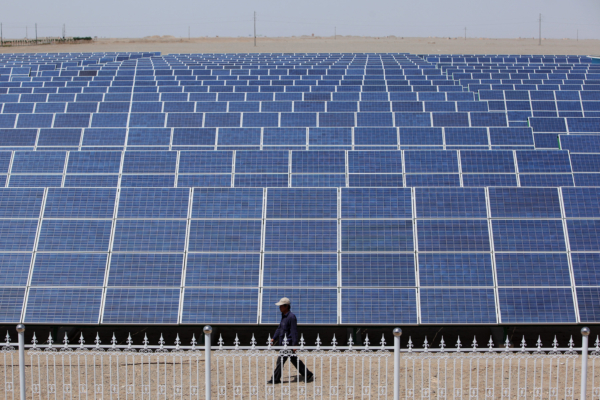In early September, six solar-related companies in Jiangsu and Zhejiang were declared bankrupt or entered into reorganization procedures by the court due to debt crises. Another company has entered pre-reorganization. Several interviewees have pointed out a trend of concentrated shutdowns in the solar industry and its supporting businesses.
On September 1st, Jiangsu Yuansheng Solar Photovoltaic Co., Ltd., a subsidiary of Jiangsu Yuansheng Solar Group Ltd., filed for bankruptcy with the Rugao City Court, with a case number of (2025) Su 0682 Po Shen 65. The company, established in 2023 and controlled by Wu Daoyuan, operates in the manufacturing, sales, and leasing of solar equipment and components. According to the court announcement, the company has 31 pending enforcement cases with an execution target of around 180 million yuan.
On September 3rd, Changzhou Purple Crystal Peak Photovoltaic Installation Engineering Co., Ltd. was brought before the Jintan District Court for bankruptcy review (case number: 2025 Su 0413 Po Shen 64). Following this news, some suppliers expressed concerns about the inability to recover receivables and swiftly submitted debt claim materials to the court.
Also on the same day, listed company Huadong Heavy Machinery announced that its subsidiary, Huadong Solar Energy Technology (Xuzhou) Co., Ltd., has entered bankruptcy reorganization and publicly invited investors. The company disclosed debts exceeding 1.1 billion yuan with its parent company, Wuxi Huadong Solar Energy Technology Co., Ltd. Five years ago, Huadong Heavy Machinery made a bold move into the solar industry, seen as a transformational model, but is now undergoing judicial reorganization.
Insiders revealed to Dajiyuan that these enterprises in northern Jiangsu are mainly local key-supported new material projects. However, with the collapse of the funding chain, most employees have been laid off since this spring, leaving only a few on “leave” with actual operations halted.
Moreover, Yangzhou Bangjie New Energy Technology Co., Ltd. has been ordered to undergo pre-reorganization by the Suzhou branch of Xingye Bank, while Shuyang Xinda New Material Co., Ltd. has also been accepted for reorganization and has issued a public announcement inviting investors.
Mr. Zhu, a person in charge of a solar auxiliary materials factory in Changzhou, Jiangsu, mentioned in an interview that the industry is undergoing significant internal competition, with order prices continuously declining, leading many companies to operate at a loss.
He said, “Over the past two years, many companies have been pressured by large companies with price reductions of up to 30%, to the point where they can’t even recover labor and electricity costs. The government talks about anti-monopoly every day, yet the ones truly monopolizing the market are state-owned enterprises.” He believes that the bankruptcy of small and medium-sized enterprises is only a matter of time, not due to individual company mismanagement but as a result of the industry’s cutthroat competition.
The industry chain landscape indicates that central and state-owned enterprises hold advantages in upstream resources and power plant terminals. Among the “Top Ten Photovoltaic Enterprises” list compiled by reporters, central and state-owned enterprises collectively account for around half.
On September 10th, Jisheng (Zhejiang) Photovoltaic Equipment Sales Co., Ltd. applied for bankruptcy, which was accepted by the Kecheng District Court in Quzhou. Data shows that the company’s registered capital is only a few million yuan, but it has undertaken a considerable amount of equipment distribution business in the past two years. Against a backdrop of declining prices, inventory write-downs and cash flow pressures have increased concurrently, exposing operational risks rapidly.
A Zhejiang industry observer, Mr. Mou (alias), described the Chinese economy as a “mess.” He stated, “From inadequate production capacity to overcapacity, it only took one year. Price wars have consumed the cash flow of many enterprises and eradicated the survival chances of small and medium-sized businesses.”
He further revealed that several solar companies have already relocated their operations to India or Saudi Arabia, with Jinko Solar having initiated a project to establish a factory in Saudi Arabia.
During a recent New Energy Industry Forum, Qian Jing, Vice President of Jinko Solar, mentioned that the most significant risk facing the solar industry post-2025 is not overcapacity but global trade environment uncertainties.
She said, “Many countries other than China may shut their doors. The future risk lies in having no market; even with efficient and inexpensive products, there may be no demand. This is the most frightening risk.” She emphasized that the establishment of the Saudi factory is a key indicator for the company in 2025.
Research data shows that the layoff rate for some mainland solar industry leaders approached one-third in 2024. Overcapacity and price declines have compressed profits, causing many manufacturers to halt or limit production.
Zhao Hong, a manager at a Zhejiang equipment supplier, admitted that during the industry’s prosperous period, capital and local governments were eager to expand production, with little consideration for actual demand. Some companies exaggerated their production capacity expectations during financing, resulting in rapid debt expansion. “Banks were willing to lend, but factories were left idle within two years of construction.”
Wang Jie, an analyst who has long tracked the solar market, pointed out that so-called “clearing low-quality production capacity” is more about redistributing interests. “Leading companies advocate for rational competition, but they also rely on low-price strategies that squeeze out the survival space of small and medium-sized factories. It’s too late to talk about quality priority today.”
Wang Jie also believes that new energy was once a star industry supported by the Chinese Communist Party through financial subsidies to stimulate the economy and exports. However, the series of solar company bankruptcies in September 2025 indicates a fate similar to that of electric vehicles. He predicts that more solar companies will be eliminated in the second half of the year, calling it an inevitable trend.

